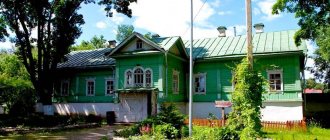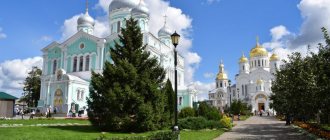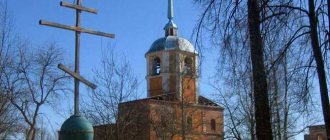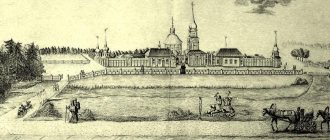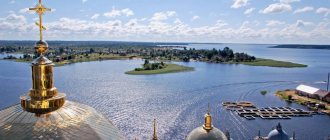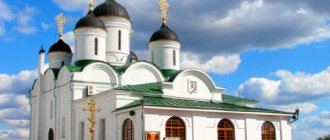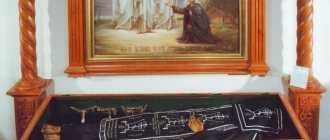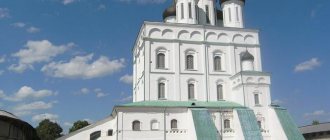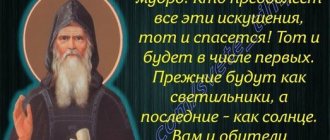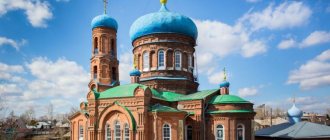| Pskov Trinity Kremlin Cathedral |
Pskov and Porkhov Diocese of
the Pskov Metropolis of the Russian Orthodox Church
- Diocesan administration: Russia, 180000, Pskov, st. Profsoyuznaya, 10
- Tel.
- Official site:
- Canonical territory: Pskov, Gdovsky, Dedovichsky, Dnovsky, Ostrovsky, Palkinsky, Pechora, Plyussky, Porkhovsky, Pskovsky, Pytalovsky and Strugo-Krasnensky districts of the Pskov region.
- Cathedrals: Trinity in Pskov, St. Nicholas in Porkhov
- On the map: Yandex.Map, Google map
As part of the Novgorod diocese
According to legend, the first Orthodox monastery arose on Pskov land under Equal-to-the-Apostles Princess Olga, in Vybuty.
Since ancient times, Pskov and the surrounding lands were part of the Novgorod diocese, and the Novgorod archpastor ruled the Pskov land through governors. Several dozen monasteries arose in the Pskov land. The Church honors the memory of many saints from these regions. Among them are the venerable martyrs Abraham and Vasily of Mirozh, Joasaph of Snetogorsk, the venerable Euphrosynus and Serapion of Spaso-Eleazar, Savva and Korniliy of Krypetsky, Onuphrius of Malsky, Dosifei of Verkhneostrovsky, Hilarion of Pskovozersky, Nikandr the Desert Dweller, the Pskov-Pechersk venerables Jonah, Mark, Vassa, Lazarus, Cornelius, Simeon and many others. All saints of the Pskov land are honored by the cathedral memory.
After the Bolotov Treaty in 1348, when Novgorod renounced political power over Pskov and called it “his younger brother,” the Novgorod ruler retained the right to enjoy certain income from Pskov churches and clergy, but it became difficult to provide active pastoral care to the Pskovites. Those seeking the priesthood often went not to Novgorod, as they should have, but to Moscow or Lithuania. By the end of the 14th and beginning of centuries, the church condition of Pskov was disappointing: Pskov priests did not know the church charter; did not have serviceable liturgical books; sometimes they baptized through pouring; used Latin myrrh; widowed priests married a second time and continued to officiate; the laity interfered in monastic and church affairs, they themselves judged and punished the clergy.
All the disturbances in the Pskov church and spiritual life were affected by the absence of their own Pskov archpastor, and in 1464 the Pskovites made another attempt at a meeting for all Pskov to send an embassy to Moscow with a request to Grand Duke John III Vasilyevich to “ bless his fatherland Pskov, order his father to to the pilgrim, Metropolitan Theodosius, to install a ruler in Pskov and our Pskovite
"
The Grand Duke refused to establish the Pskov See, because “ it did not exist from time immemorial
.” The Grand Duke’s refusal also reflected the long-standing distrust of the Moscow authorities towards the Pskovites.
Formation of the diocese
The heroic defense of Pskov from the army of the Polish King Stefan Batory in 1581 eliminated doubts of the Moscow government regarding the loyalty of the Pskovites. When the patriarchate was established in the Russian state, with an increase in the number of dioceses, Pskov, as if as a reward for loyalty, received a long-desired bishop - the independent Pskov diocese was separated from Novgorod on January 26, 1589. The space of the Pskov diocese was initially limited to the five nearest cities and districts: Pskov, Izborsky, Ostrovsky, Opochetsky and Gdovsky.
Since July 6, 1616 - archbishopric. The Council of 1682 decided to divide the Russian Church into 13 metropolises, 6 archdioceses and 49 bishops, in connection with which the Pskov diocese was elevated to the dignity of a metropolitanate.
Synodal period
Bishop Feofan (Prokopovich) became the first Pskov bishop of the new period in 1718, the right hand of Tsar Peter I in the church reformation of that time. Bishop Feofan lived in St. Petersburg, for which purpose he established a Pskov courtyard there and complained to the emperor, like the previous Pskov rulers, about the self-will of the Pskov people, when the townspeople owned church estates and lands and did not pay taxes. In Pskov, under Feofan (Prokopovich), 18 monasteries and 23 churches (41 churches in total) were assigned to the Bishop's House, while Bishop Feofan wrote to the emperor that “the diocese entrusted to me is very meager.” Upon the establishment of the Pskov province by Peter I, Zavolochye, Krasnoe Gorodishche [1], Pustorzhevsky (Novorzhevsky) district and Kobylinsk were assigned to the diocese. In 1725, the newly conquered city of Riga with its district was also included in the Pskov diocese.
In 1733, the Pskov Theological Seminary opened.
The Pskov ruler Simon (Todorsky) also stayed in St. Petersburg in the middle of the 18th century. Taking advantage of his absence and soft-heartedness, the rulers in Pskov “ carried out various acts of arbitrariness, robberies, robberies and bribes.”
", about which there were constant complaints from the bishop's peasants in St. Petersburg.
“ From the unrest and devastation caused by these managers, clerks and solicitor Blichkin with his clerks, the peasants fled to God knows where, some notably beyond the Polish border
.” However, Bishop Simon was merciful in his punishments. Under him, the seminary building was rebuilt in 1747, which the bishop took special care of.
In the 1760s, Velikoluksky Uyezd was added to the Pskov diocese. With the time of the transformation of the Pskov province into a province from 1773, and then from 1777, the cities of Kholm and Porkhov with counties were transferred from the Novgorod diocese to the viceroyalty of Pskov, and Sebezh, Polotsk, Nevel, Dvinsk (now Daugavpils) and Vitebsk from the Belorussian diocese . In 1781, Gdovsky district became part of the St. Petersburg diocese, and since 1798, Belarusian cities again became part of the Belarusian diocese. From the Smolensk diocese in 1787, Toropets with the district was assigned to the Pskov diocese.
In 1808, four theological schools were opened in the diocese: Pskov, Velikolukskoe, Porkhovskoe and Toropetskoe.
Livonia and Courland, which were under the spiritual authority of the Pskov archpastors, in 1850 went to the newly established Riga diocese. From 1849 to 1858, the Archbishop of Riga simultaneously ruled the Pskov diocese. By the beginning of the century, the boundaries of the territory of the Pskov diocese coincided with the administrative boundaries of the Pskov province.
In 1887, the Pskov Diocesan School for daughters of the clergy was founded.
By 1895, priest Vasily Triumfov in the Bezhanitsy churchyard organized, following the example of Righteous John of Kronstadt, the first temperance society in the province [2]. In 1905, Archbishop Arseny opened a psalm school, called Arsenyevskaya, organized in 1908 the Church Archaeological Committee, the Museum of Church Antiquities, and many other undertakings are associated with his name, designed to help attract secular people to the life of the Church. Under Bishop Alexy in 1910-1912, the Diocesan Temperance Committee was created, the bishop himself resumed and headed the pastoral meetings of the Pskov clergy, and strengthened anti-sectarian activities.
Soviet period
After the October Revolution of 1917 and the victory of anti-Christian forces in Russia, an acute conflict arose between the new government and the Church, which also manifested itself in the Pskov land. In February 1919, the Bolsheviks opened the shrine containing the relics of the blessed Prince Vsevolod-Gabriel, but the veneration of the saint by believers was so great that the authorities did not dare to remove the relics from the cathedral.
The “renovationism” promoted by the authorities in the Pskov diocese had little success - even during the period of the highest renovationist upsurge, Bishop Gennady (Tuberozov) remained faithful to St. Tikhon and the canonical Church. For some time, out of respect for his years, the people tolerated the renovationist “Archbishop” Dmitry Rozhdestvensky, but already in September 1923, the diocese was again headed by Bishop Varlaam (Ryashentsev), faithful to the Church. He suffered in 1924 for the miraculous renewal of many icons in the Pskov diocese, because... The Bolsheviks believed that this was a falsification. As the OGPU department reported, there are 336 parishes in the Pskov province, 70% are completely Tikhon, and 30% “ do not dare to openly choose a certain direction, but have a hidden attraction towards Tikhon
" While “renovationist” priests served in the Trinity Cathedral, the Church of the Archangel Michael was consecrated into a cathedral in 1929.
During the 1920s, all 14 monasteries in the Pskov province were closed. This fate did not affect only the Pskov-Pechersky Monastery, which ended up on Estonian territory, abroad.
The first five-year plan of 1928 was called the five-year plan of atheism - anti-bell campaigns took place, churches were closed and rebuilt into workshops, artels, etc. A new round of repressions against the clergy in the Pskov land began in the early 1930s and lasted almost until the start of the Great Patriotic War. In 1935, the Trinity Cathedral was closed, and in 1939 an anti-religious museum was opened in it. In January 1941, the last church in Pskov, the Church of Demetrius the Myrrh-Streaming in Pole, was closed.
In total, during the period 1918-1940 in the Pskov diocese, according to incomplete information, 250 clergy were shot, and about 1,000 clergy, monastics and laymen were sentenced to various terms of imprisonment.
During the war, thanks to the activities of the Pskov spiritual mission under the German occupation, church life was revived and the existence of the Pskov diocese continued in the changed post-war conditions. Thanks to the activities of Metropolitan John (Razumov) of Pskov, who ruled the diocese for more than 30 years, about 80 functioning churches and a monastery have been preserved within its boundaries - an exceptional case in the USSR.
Modern times
A new revival of church life in the Pskov region followed from the end of the Soviet period. During the years of Metropolitan Eusebius’ reign, by the end of the 2000s, more than 100 churches and chapels were built and restored in the diocese, and the bishop performed about 250 ordinations as presbyter and deacon. Monastic life has been revived in Svyatogorsk, Mirozhsky, Snetogorsk, Krypetsky, Nikandrovsky, Spaso-Eleazarovsky, Tvorozhkovsky, Vvedensky and Simansky Spaso-Kazansky monasteries. The Pskov-Pechersky Monastery received further development, which is still the spiritual center not only of the Pskov diocese, but of all of Russia.
On December 25, 2014, the independent Velikolukskaya diocese was separated from the Pskov diocese, after which the first remained under the jurisdiction of the cities of Pskov, Gdovsky, Dedovichsky, Dnovsky, Ostrovsky, Palkinsky, Pechora, Plyussky, Porkhovsky, Pskovsky, Pytalovsky and Strugo-Krasnensky districts in the north. east of the Pskov region. At the same time, the Pskov diocese was included in the newly formed Pskov Metropolis [3].
Historical names
- Pskov and Izborsk (January 26, 1589 - 1717) [4]
- Pskov and Narva (1718 - January 13, 1764) [5]
- Pskov and Riga (January 13, 1764 - October 16, 1799)
- Pskov, Livlyandskaya and Courlandskaya (October 16, 1799 - April 30, 1833)
- Pskov and Livlyandskaya (April 30, 1833 - March 11, 1850)
- Pskovskaya and Porkhovskaya (March 11, 1850/1858 - mentioned September 16, 1927)
- ? Pskovskaya and Velikolukskaya
- ? Pskovskaya and Toropetskaya
- Pskovskaya and Porkhovskaya (mentioned May 26, 1944, mentioned November 11, 1954 - April 3, 1990)
- Pskovskaya and Velikolukskaya (April 3, 1990 - December 25, 2014)
- Pskovskaya and Porkhovskaya (since December 25, 2014)
Statistics
- 1725 – 140 churches [6].
- beginning V. - 38 deaneries (each of the 8 districts of the province has 4-6 districts), 554 churchyards and city churches, 969 chapels, 1070 clergy (29 archpriests, 466 priests, 158 deacons, 424 psalm-readers), 14 monasteries, diocesan Ilyinsk community nurses, 39 almshouses and 4 hospitals [6].
- 1912 - bishop's houses - 2; churches - 554, chapels - 969; monasteries - 13 (5 women's), 3 women's communities, 2 monastery farmsteads; 1 theological seminary, 4 theological schools, 409 church schools; libraries at churches - 178; hospitals - 4, almshouses - 39.
- January 1, 1958 [7] - 107 registered temples/houses of worship.
- beginning 1993 - 80 operating churches.
- April 2008 - 211 churches, 108 chapels, 178 priests, 19 deacons [6].
- June 2015 - 9 monasteries (4 men's, 5 women's); 159 temples, 96 chapels; 140 elders, 15 deacons; inhabitants of the monasteries: male (including the priesthood) - 148, female - 177 people. [8]
Bishops
- Misail (April 1589 - April 21, 1592)
- Varlaam (Belkovsky) (1592 - 1595) high, metropolitan. Novgorod
- Mikhail (Desnitsky) (February 15, 1815 - February 7, 1816) v/u, archbishop. Chernigovsky
- Platon (Gorodetsky) (June 27, 1849 - April 15, 1856) v/u, bishop. Rizhsky
- German (Ivanov) (1902) v/u, ep. b. Lublinsky
- Gennady (Tuberozov) (1912) v/u, ep. Balakhninsky
- Nikolai (Pokrovsky) (January 24, 1924 - 1927) high school bishop. Tobolsk
- Nikolai (Yarushevich) (1936 - 1940) high school bishop. Peterhofsky, Lutsk
- Grigory (Chukov) (September 7, 1945 - 1949) supreme, metropolitan. Leningradsky
- Grigory (Chukov), 2nd time (1949 - November 11, 1954) high school, Metropolitan. Leningradsky
- John (Razumov) (March 6, 1959 - June 21, 1960) bishop. Berlin
LiveInternetLiveInternet
Quote from Roman_Torchagin
Read in full In your quotation book or community!
Pskov Mission: The Church was with the people
Ksenia Luchenko
The film "Pop", coming out in April, is an occasion to start a serious conversation about the Church and the people during the war. The Pskov mission is one of the most tragic and heroic pages in the history of World War II. Today we offer an interview with historian Konstantin Obozny, author of the book “History of the Pskov Orthodox Mission” - the most complete study of this topic.
| Patriarchal Exarch of the Baltic States Metropolitan Lithuanian and Vilensky Sergius (Voskresensky). |
— Konstantin, author of the novel “Pop” Alexander Segen calls you one of the consultants who helped him in his work. Do you agree with his vision of the Pskov mission and the views and sentiments of its members?
— Alexander Segen’s work is artistic in concept, so you shouldn’t be too strict about some discrepancies in historical terms. At the same time, it is noteworthy that the author created the central line of the book entirely on the basis of the memoirs of a member of the Pskov Mission, Archpriest Alexy Ionov, “Notes of a Missionary.”
Quite problematic in the book, in my opinion, is the assertion that the Pskov Orthodox Mission is the brainchild of the German occupiers. In fact, the Pskov Mission was not established on the initiative of the German authorities, especially since Adolf Hitler was absolutely not involved in this. A whole block of documents from the occupation authorities is known on this issue, which reveals their true attitude towards church revival. Without the spontaneous church revival that began in the Soviet territories occupied by the Germans, there could not have been a Mission. Exarch Sergius, trying to help the civilian population and support this spiritual upsurge, begins difficult negotiations on the establishment of the Pskov Mission. The Germans did not initiate the creation of the Mission, but rather made a concession to Metropolitan Sergius (Voskresensky), who is the main “culprit” for the creation of the Mission. Of course, without the permission of the occupation authorities, the activities of the Mission would be impossible, but the emphasis must be placed correctly, otherwise we will end up with the same scheme that Soviet historians so unanimously wrote about - the German intelligence services established the Mission to use the church in the enslavement of the Russian people and as a spy, treacherous activities. The figure of the German colonel, who was allegedly sent by Hitler himself to the Pskov region, looks implausible. Of course, there could be (and there were) German officers and soldiers who treated the Orthodox Church with respect and even sympathy, but it is unlikely that there were special emissaries sent by the Fuhrer himself.
A small inaccuracy with the main character, who took his mother with him on a missionary trip to Pskov. The first group of missionaries, which arrived from Riga to Pskov on August 18, 1941, consisted of only 15 priests and psalm-readers. Wives and children were not taken on the missionary trip. The priests themselves did not know what awaited them in Pskov (especially since Exarch Sergius did not give a blessing to one of their missionaries in response to a similar request - to take their mother with them). This was an extremely risky move. Some missionaries, after settling in their places of service, brought families from Latvia, but this was 1942-1943. For example, Father Georgy Taylov. The wives and infants of fathers Georgy Bennigsen, Alexy Ionov and others remained in Riga throughout the service of their husbands in the Pskov Mission.
| Archpriest Georgy Taylov - member of the Pskov Mission (photo from the early 1990s), in 1943-1944 was dean Pushkinogorsk district |
Regarding the confession that the main character takes from a young partisan. Considering that the priest is an enlightened and true Christian, he could not say in confession that killing a German or a traitor is not a sin. It could be in a different form. In the Byzantine Empire, Orthodox soldiers who defended their fatherland and Orthodoxy from infidels, and who killed the enemy in battle, were subject to penance, that is, they went through a period of repentance in order to again participate in the sacrament of the Eucharist without prohibition. After all, killing a person (regardless of who he is in relation to us) always remains a spiritual and unnatural act at the same time, destroying the personality of the killer, and therefore is always a sin.
The final part of the book also contains a disturbing passage. The words of the main character, the priest, who returned from a forced labor camp, are completely incomprehensible and even false, that under Stalin the war was won (read under the wise leadership of the Leader), and he gave relief for the Church. Such people understood perfectly well what all these “changes” were worth, and there could not be even a shadow of reverence for the Soviet leadership. We should not forget that the main character was not a Soviet man, he came to the Pskov land from the Baltic states, where the clergy, neither in the pre-war years nor after the end of the war, were generally not distinguished by their loyalty to the Stalinist regime. This statement may seem too categorical. I have reasons for this, since I was lucky enough to meet some members of the Pskov Mission, their descendants, students who, regarding the role of Stalin in the fate of Russia and Europe, are distinguished by Christian sobriety - evil must be called by its name!
— To what extent do the images created by Seguin of the members of the Pskov mission who were eaten under their real names coincide with documentary sources, with real people?
| Protopresbyter Kirill Zaits. spring 1944. Siauliai, Lithuania (during this period, Father Kirill headed the activities of the Internal Orthodox Mission in Lithuania). From December 1, 1941 to February 1944. Protopresbyter Kirill Zaits - Head of the Department "Orthodox Mission in the liberated regions of Russia" with a center in Pskov |
— The author of the book really brought out images of several real historical figures - this is Exarch Sergius (Voskresensky), from the leadership of the Mission - Protopresbyter Kirill Zaits, priest Georgy Bennigsen, Archpriest Sergiy Efimov. It is difficult to talk about some identity of artistic images with real historical figures, given
| Archpriest Sergiy Efimov - Head of the Office of the Orthodox Mission in the liberated regions of Russia" in August-September 1941 (photo from the late 1950s-early 1960s) |
the fact that we are dealing with a work of art, and not a scientific work. It is quite natural that the author, willingly or unwillingly, conveys his attitude, the concept of a person at the beginning of the 21st century, to his heroes. Most of our compatriots over the age of 40, in the process of personality formation, were subjected to the strong influence of communist ideology (even if they were not “ideological”), which still operates in us, including those who entered the church fence... But this were completely deprived of influence, and therefore people like Kirill Zaits, Alexey Ionov, Georgy Bennigsen were freer than us. That is why it is very, very difficult for a modern writer to convey their accurate portraits. The same applies to Metropolitan Sergius (Voskresensky) himself, a large-scale, complex, and sometimes contradictory figure. Regarding the personality and role of the exarch, there is always a temptation to portray him as a German henchman, or vice versa as a pro-Soviet bishop, an agent of Soviet intelligence, etc. In my opinion, Sergius (Voskresensky) was neither the first nor the second.
In both cases, the exarch’s church activities would not have been able to bear so many important spiritual fruits. At the same time, one must pay tribute to his remarkable organizational talent, wisdom, diplomatic tact, but most importantly - Christian firmness and devotion to the Church, that is, to his flock, for which he ascended to his Calvary. There is also no clear version about the death of Metropolitan Sergius. Most modern researchers believe that the murder of the head of the Baltic Exarchate was prepared and carried out by German intelligence services. However, there are some facts that allow for the possibility of another version of events. In this regard, the question about the fate of the exarch if he found himself in territory liberated from the German invaders seems rhetorical.
— The history of the Pskov mission is one of the most painful topics in the history of the Russian Church of the 20th century. Not everyone can buy and read your monograph or other research. At the same time, many have a stereotypical vision of the situation. Perhaps you can briefly formulate what the Pskov mission actually was, what was the relationship of its leadership and members with the command of the Wehrmacht and the Soviet government?
— It’s not easy to answer such a question in a short interview. As mentioned above, the Pskov Orthodox Mission was the response of the church leadership of the Baltic Exarchate to the questions and pleas of the believers of the occupied North-West of Russia to send clergy, thus supporting and directing into the church mainstream the spontaneous spiritual upsurge among the civilian population (noted, among other things, in German reports information services). Thus, the Pskov Mission was called upon to revive the church structure - to solve the problem of restoring Orthodox parishes (before the start of the war, no more than 10 Orthodox churches operated in the territory of the Pskov Mission), united into deaneries. The laity themselves carried out repairs and prepared churches for worship. In addition, the Mission’s employees were actively involved in the work of Christian education, teaching in the faith, and preaching the Gospel, both among children and youth, and among adult parishioners. Christian youth circles, church schools, parish libraries were created, catechetical meetings and extra-liturgical conversations with parishioners were held. Charitable work was carried out in the parishes, including providing material and spiritual assistance to Red Army prisoners of war. Shelters for the homeless and orphans were created at the temples. In this multifaceted activity of the Pskov Mission (especially in the matter of mission and Christian education), lay missionaries who came from Latvia and Estonia (Pechery) took an active part. Most of them went through their path of Christian and church maturity, actively participating in the activities of the Russian Student Christian Movement, a branch of which operated in the 20-30s. in the Baltics
| Archpriest Nikolai Kolibersky - Head of the Office of the Orthodox Mission in the liberated regions of Russia" in October-November 1941 |
The leadership of the Pskov Mission and its members, since they acted in the occupied territory quite legally, had to enter into relations with the occupation authorities on various issues, since literally everything required permission from the military commandant and other departments of the occupation authorities (from the right to move through the territory occupied by the occupiers , for which it was necessary to obtain a pass, before the opening of churches and the establishment of schools and shelters with them).
According to Archpriest Alexy Ionov, Orthodox clergy treated the German authorities as evil, but a lesser evil. For the majority of clergy and laity, both the German and the Soviet regimes are not just totalitarian regimes, but anti-Christian, anti-human regimes, and therefore they are evil. However, in comparison with the Soviet system, for many members of the Mission, the German occupation authorities, unlike the Soviet authorities, were a lesser evil, since they did not interfere with the restoration of church life, the preaching of the Gospel, and the spiritual nourishment of the civilian population. Of course, German propaganda tried to use this fact for its own purposes, emphasizing in every possible way the tolerance and religious tolerance of Greater Germany, which was supposedly called by God to “liberate” Russia from communist rule. The occupation regime tried to involve representatives of the Orthodox Church in its propaganda “games.” why it was necessary to obtain a pass, on issues related to the occupied territory, since literally everything needed permission
Thus, we can say that the leadership of the Pskov Mission and its employees were forced to come into contact with the occupation authorities (someone will use the word “cooperate”) in order to openly serve, support their flock during the difficult war years and help the Russian people return to God and to the Church. For a non-church person, the latter arguments are completely unconvincing - not only in the Soviet years, but even today one can hear the opinion that nothing can “justify” the Orthodox priests who served with the permission of the German occupiers. Hardly anyone thinks that if in the occupied territories there were no legal services in Orthodox churches, which were performed by clergy members of the Moscow Patriarchate, then this spiritual vacuum would be filled by other religious movements, sectarian and non-Christian groups. By the way, this is exactly what the Fuhrer dreamed of.
The service of the Pskov Orthodox Mission in no way pursued the goals of the occupation regime, because for the latter it was desirable to deal with a weak, fragmented people, warring within themselves, who were easy to control. It was the Orthodox Church that gathered the post-Soviet population in the occupied territory into the people of God. It was the Church, following Christ, that united the Russian people and helped them survive the war. In this vein, it becomes clear how lightweight theses about the “great” role of the NKVD, the Communist Party, and Generalissimo Stalin are in the matter of victory.
Returning to the topic of cooperation between members of the Pskov Mission and the occupation authorities, I would like to note that a number of facts indicate the difficult relationship of the Orthodox Church with the German occupation regime. Behind the external loyalty and emphasized respect, distrust and irritation were hidden. This also concerned the attitude of the German leadership towards Exarch Sergius, the ban on teaching lessons of the Law of God in schools, attempts to transfer church life to a new calendar, obstacles that were created in the matter of spiritual and material care for prisoners of war, finally, the arrests of priests and clergy, and vigilant control for the activities of the Mission.
| Pskov Cathedral of the Holy Trinity during the German occupation |
The most serious accusation against the employees of the Pskov Mission was and remains treasonous activity - collecting information about the Soviet underground and partisan movement, handing over Soviet patriots to the German authorities, etc. Adherents of this point of view can, unfortunately, be found today in church circles. If the Pskov Mission was not a church institution, but a spy organization, then it is unlikely that the church revival could have taken place at all and brought such abundant fruits. A serious argument in the injustice and falsity of such accusations is the rehabilitation (1956) of the clergy of the Pskov Mission, who were convicted in 1944-1945. for allegedly treacherous, espionage activities.
The relationship between the Pskov Mission and the Soviet government is also one of the “pain points” of this topic. At first glance, it is appropriate - what kind of relationship could there be if the Pskov Orthodox Mission operated in territories occupied by German troops? Firstly, the Soviet leadership was well aware of the processes of church revival in the occupied territories. There is an opinion in scientific circles that this was precisely what became in 1943 one of the important reasons for the start of a new course of church-state relations in the USSR. Secondly, in the occupied territories of North-West Russia, the authorized representatives of the Soviet government were partisan units operating under the leadership of the LSPD (Leningrad Headquarters of the Partisan Movement). Each partisan detachment had so-called organizational troikas, whose functions included the following tasks: collecting food, clothing and material assets from the local population, agitation and propaganda (distribution of newspapers, leaflets, appeals from the Soviet government, etc.). In addition, the organizational troikas had judicial and executive powers, that is, they passed sentences and carried them out against those who violated Soviet laws, engaged in anti-Soviet activities, and collaborated with the occupiers. As a rule, the members of the organizational troika were leaders of party organizations, prosecutors and police officers, that is, those who in the pre-war years were in one way or another associated with repression, including against the Orthodox episcopate, clergy and laity. War conditions created an emergency situation (much could be attributed to the war), when completely innocent people died at the hands of representatives of the organizational troikas. Clergymen in the occupied territory who opened churches with the permission of the occupation authorities automatically fell into the category of traitors and collaborators. It is known for certain about two cases of murder of clergy by partisans in the territory cared for by the Pskov Mission. There are no statistics on clergymen, church elders and laymen who died as a result of the sentence in the North-West of Russia.
Since 1943, more and more facts have emerged about the loyal attitude of partisan units to the Pskov Mission. This is due to various reasons. It was in this year that the official policy of the Soviet government towards the Orthodox Church changed; naturally, this news spread to the territory occupied by German troops. It was this year that became a turning point in the war, the Nazi occupation policy became tougher, including the beginning of mass deportations of able-bodied civilians to Europe and Germany. Many preferred to stay in their homeland and escaped from being deported to a foreign land in partisan detachments. This is what contributed to the increase in the percentage of the local population in partisan formations, who knew firsthand about the works of the clergy of the Pskov Mission.
| Procession under the walls of the Cathedral in Pskov, 1943 |
Finally, the last thing we need to pay attention to in this direction is that we are faced with a significant contradiction, which helps once again to understand the anti-people essence of the Soviet government. After the liberation of North-West Russia and the Baltic states from German troops, the most active and zealous members of the Pskov Mission (some of them are still remembered by grateful older Pskovites) were arrested by SMERSH officers and sentenced to long terms of imprisonment in Stalinist camps. These were the best of the best, those who served God and neighbor without sparing themselves, their well-being and even their lives. It was they who were so terrible for the Soviet government, for the inviolability of the totalitarian system, because they helped the people get rid of chilling fear and gain spiritual freedom through the acquisition of true faith and life in Christ. Here, by the way, one can clearly see the similarities between the Soviet and Nazi systems.
| Members of the Pskov Orthodox Mission on the territory of the Pskov Kremlin, 1943 (Konstantin Kravchenok, Rostislav Polchaninov, Raisa Matveeva, Nikolay Saburov, Olga Koshko, archaeologist from Novgorod - presumably Vasily Ponomarev?) |
— What was the fate of the priests of the Pskov mission after the war? What percentage remained in the USSR, and what percentage went into exile? How did the church leadership in subsequent years treat the former members of the Pskov mission who remained in the USSR? In the church environment, the authority of, for example, Archimandrite Kirill (Nachis) was great; how was his relationship with the authorities - church and Soviet? How did he talk about the Pskov mission?
— Basically, the post-war fate of the members of the Pskov Mission (clergy and laity) developed in three directions —
1. approximately 15-20 people left for the West in 1944
2. remained in their homeland and were repressed in 1944-1952. 60-65 people
3. 80-85 people remained in their homeland and were not subject to repression
From the first group we can single out Archpriest John the Legion, who in the Pskov Mission was the dean of the Gdov district, and in exile rested in the rank of bishop
| Archpriest Alexy Ionov - member of the Pskov Mission, dean of the Ostrovsky district (1941-1943), author of the memoirs “Notes of a Missionary” |
Rockland in 1995. Many members of the Pskov Mission, once in the West, continued their missionary service for Russian emigrant refugees of the second wave - Archpriest Georgy Bennigsen, Archpriest Alexy Ionov, Archpriest Theodore Mikhailov and others.
Statistical calculations suffer from inaccuracy, since the life path of some members of the Mission is not completely clear: traces of some Mission employees are lost during the total evacuation to the Baltic states, it is known about some Mission members that they were arrested, but further information is completely absent. Also complicating the research is the fact that the arrests of some members of the Mission continued until Stalin’s death.
Missionary priests from the third group, those who were not arrested, were constantly in a state of waiting; they were not immune from oppression by the godless authorities, deprivation of registration, blackmail, pressure, etc. The Commissioner of the Council for the Affairs of the Russian Orthodox Church for the Pskov Region in his reports in the post-war years he repeatedly emphasized that the clergy serving in the occupied territories required special attention from the Soviet government. The Soviet government did not trust, and, more precisely, was afraid of the clergy from the Pskov Mission.
It was especially difficult for those priests from the Mission who, after being released from the camps, returned to their homeland, to their families. Often, local authorities, primarily the authorized representative of the Council for the Affairs of the Russian Orthodox Church, tried in every possible way to prevent such clergy from returning to service in the Church, and if places were allocated, these were, as a rule, rural, remote small parishes.
Despite this, it was these priests who formed the flower of the Russian Orthodox Church in the northwestern regions and the Baltic states - Archpriest Sergius Efimov, Archpriest Iakov Nachis, Archpriest Nikolai Trubetskoy, Archpriest Nikolai Shenrok, Archpriest Konstantin Shakhovskoy, Archpriest Liveriy Voronov, Archpriest Georgy Taylov, Archimandrite Kirill (Nachis).
They earned well-deserved love from the flock and respect from the hierarchs. At the same time, I was lucky enough to meet some of them, or the descendants of Pskov missionaries. All of these were people who were not only selfless and devoted to Christ, but also extremely modest and ascetic in everyday life. Archimandrite Kirill, for example, talking about missionary trips with his older brother in the occupied Pskov region, emphasized that they did not do anything special - baptized, held funerals, performed divine services and consecrated churches. Everything is as usual in priestly practice, but the members of the Mission had to pay for carrying out this feat with health, freedom, and for some, life itself.
I regard my personal contact with their experience of Christian life and missionary service as a great mercy and gift from the Lord.
The editors thank Konstantin Obozny for the photographs provided.
https://www.taday.ru/text/358904.html
Monasteries
- Vladimiretsky Vvedensky (female)
- Krypetsky (male)
- Mirozhsky (male)
- Nikandrovsky (male)
- Pskov-Pechersky (male)
- Simansky (female)
- Snetogorsky (female)
- Spaso-Eleazarovsky (female)
- Tvorozhkovsky Trinity (female)
Inactive:
- Great Pustynsky (male)
- Ioanno-Predtechensky (female)
- Malsky Spaso-Rozhdestvensky (male, since 2000 it has been restored as a monastery of the Pskov-Pechersky Monastery)
Russian Orthodox Church
Part of the Pskov Metropolis
Established in 1589 (separated into an independent one from the Novgorod diocese). Initially it included the five cities and counties closest to Pskov: Pskovsky, Izborsky, Ostrovsky, Opochetsky and Gdovsky. In the 60s XVIII century Velikoluksky district was added to the diocese.
By the decision of the Holy Synod of December 25, 2014 (journal No. 118), the Velikolukskaya diocese was separated from the diocese. The Pskov diocese is included in the Pskov Metropolis. The Synod decided to have the title “Pskov and Porkhov” for the ruling bishop.
Diocese today (as of October 2020)
Deaneries and deaneries
- Gdovskoe - Hieromonk Innokenty (Seleznev Sergey Vyacheslavovich)
- Pskov district - Archpriest Georgy Bykov
- Pskov City - priest Mikhail Fedorov
- Porkhovskoye - priest Viktor Shelukhov
- Ostrovskoye - priest Roman Pavlov
- Plyusskoe - Archpriest Alexander Timofeev
- Pytalovskoe - Abbot Timofey (Kazakov)
- Pechora - Archpriest Vladimir Semindyaev
- Monastyrskoe - Hieromonk Innokenty (Seleznev Sergey Vyacheslavovich)
Monasteries
men's:
- Uspensky Pskovo-Pechersky 181500, Pskov region, Pechory, st. International, 5; tel.: (81148) 2-18-39, 2-21-45 vicar - Metropolitan Tikhon (Shevkunov Georgy Alexandrovich)
- Ioanno-Bogoslovsky Savvo-Krypetsky 181111, Pskov region, Pskov district, Kripetskoye village; tel. +7911 378-36-55 acting Viceroy - Hieromonk Vsevolod (Sikanov Vladislav Valerievich)
- Spaso-Preobrazhensky Mirozhsky 180002, Pskov, Mirozhskaya embankment, 2; tel.: +7911 691-12-34, acting Viceroy - Hieromonk Seraphim (Kozulin Alexander Viktorovich)
- Blagoveshchensky Nikandrovsky 182648, Pskov region, Porkhov district, Dubrovenskaya volost, p/o Zagoska, village. Lyubovets; tel., (81134) 6-23-45 viceroy - abbot Spiridon (Ivashchenko Sergey Ilyich)
women's:
- Nativity of the Blessed Virgin Mary Snetogorsky 180020, Pskov, Ovsishche, Snyatnaya Gora, 1; tel. (8112) 75-01-25 abbess - abbess Raphaila (Pozigunova Victoria Viktorovna)
- Spaso-Kazansky 181350, Pskov region, Ostrov, st. M. Pionerskaya, 82-3; tel.: (81152) 3-65-17, abbess - abbess Markella (Pavlova Lyudmila Viktorovna)
- Spaso-Eleazarovsky 181223, Pskov region, Pskov district, p/o Elizarovo, village. Elizarovo; tel. (81126) 7-95-58 and. O. abbess - nun Maria (Korkh Anna Yuryevna)
- Vvedensky 181327 Pskov region, Ostrovsky district, village Sigoritsy, village. Vladimirets; tel. (81152) 9-82-18 acting abbess - nun Antonina (Fateeva Nadezhda Kuzminichna)
- Holy Trinity Tvorozhkovsky 181138, Pskov region, Strugokrasnensky district, village. Finyova Gora; tel. (81132) 5-61-07 abbess - abbess Magdalena (Busygina Natalya Evgenievna)
There are 159 churches and 96 chapels in the diocese.
Number of clergy and religious
- elders - 191
- deacons - 25
Number of inhabitants of the monasteries
- male (including priesthood) - 137
- women's - 185
Diocesan media
- official website of the Pskov Metropolis
Educational establishments
- St. Tikhon's Orthodox Gymnasium, Pskov, Krasnoarmeyskaya embankment, 17/1; tel.: (8112) 20-10-31, 20-10-32
- Correspondence department of the St. Petersburg Theological Academy at the Pskov-Pechersky Monastery
***
Pskov-Pechersky Monastery
Pskov Spaso-Eleazarovsky Monastery
Icon "Savior of Eleazar"
Trinity Cathedral of the Pskov Kremlin
Pskov Theological Seminary
Monument to Saint Olga Equal to the Apostles, Grand Duchess of Russia, in Pskov,
Nativity of the Blessed Virgin Mary, Snetogorsky Monastery
Literature
- Temples and monasteries of the provincial Pskov.
Collection of pre-revolutionary publications , Pskov, Pskov Regional Printing House, 2005. - Tolstoy, M. V., Shrines and Antiquities of Pskov
, Moscow, 1861. - Smirechansky, V.D., Historical and statistical collection of information about the Pskov diocese
, part. 1-2, Pskov, 1875-1895. - Vasilev, I.I., Experience of a geographical-statistical dictionary of the Pskov province
, vol. 1-3, Pskov, 1882-1896. - Vasilev, I. I., Historical and statistical index of the city of Pskov
, Pskov, 1889. - Vasilev, I. I., Archaeological index of the city of Pskov and its environs
, St. Petersburg, 1898.
